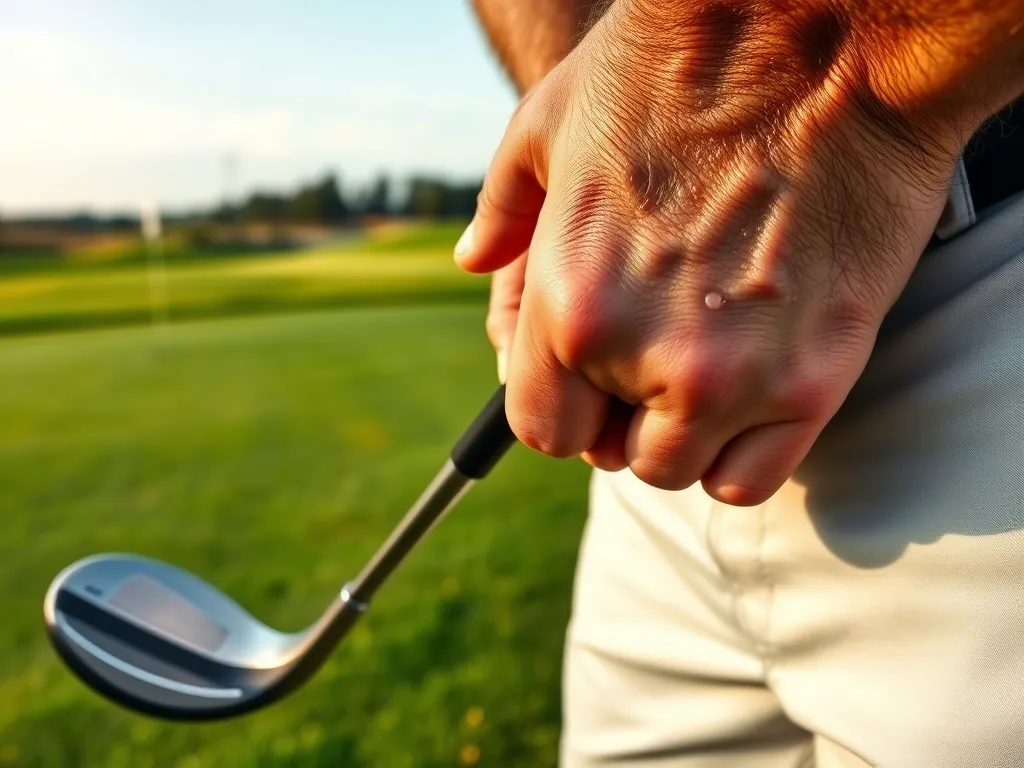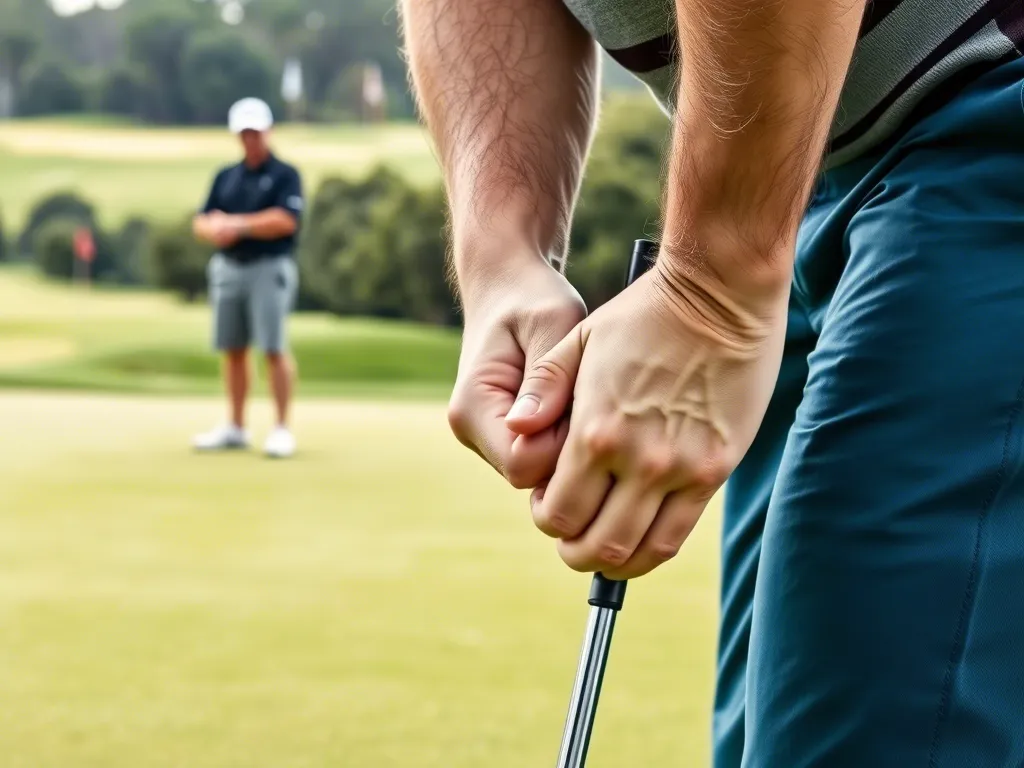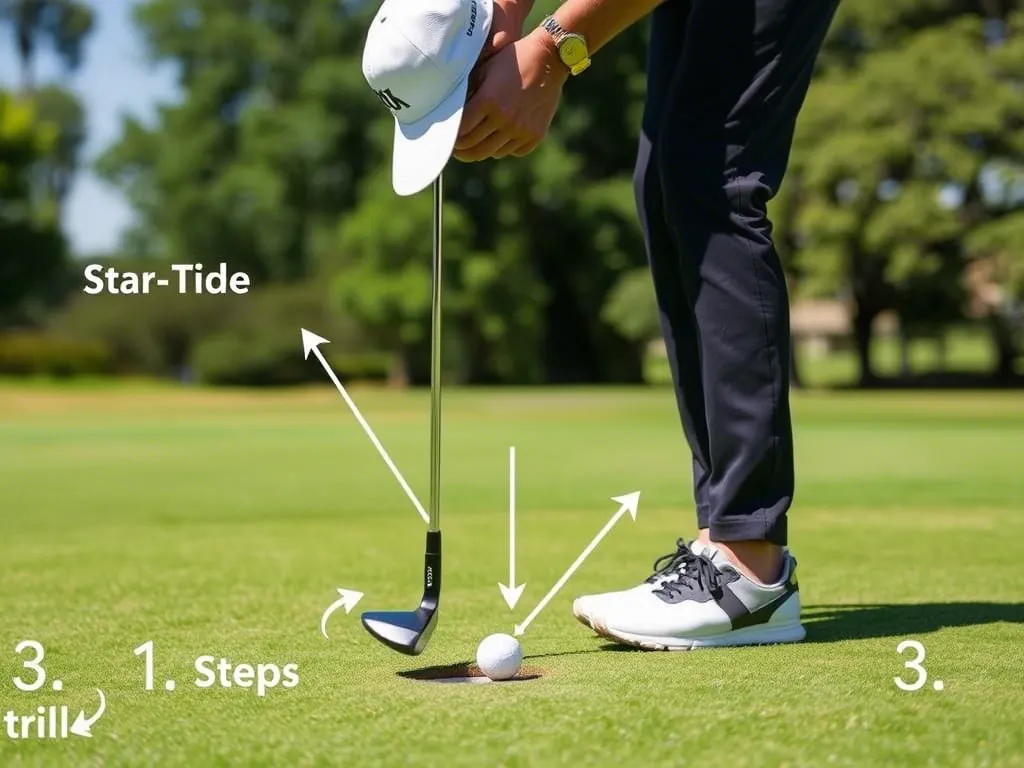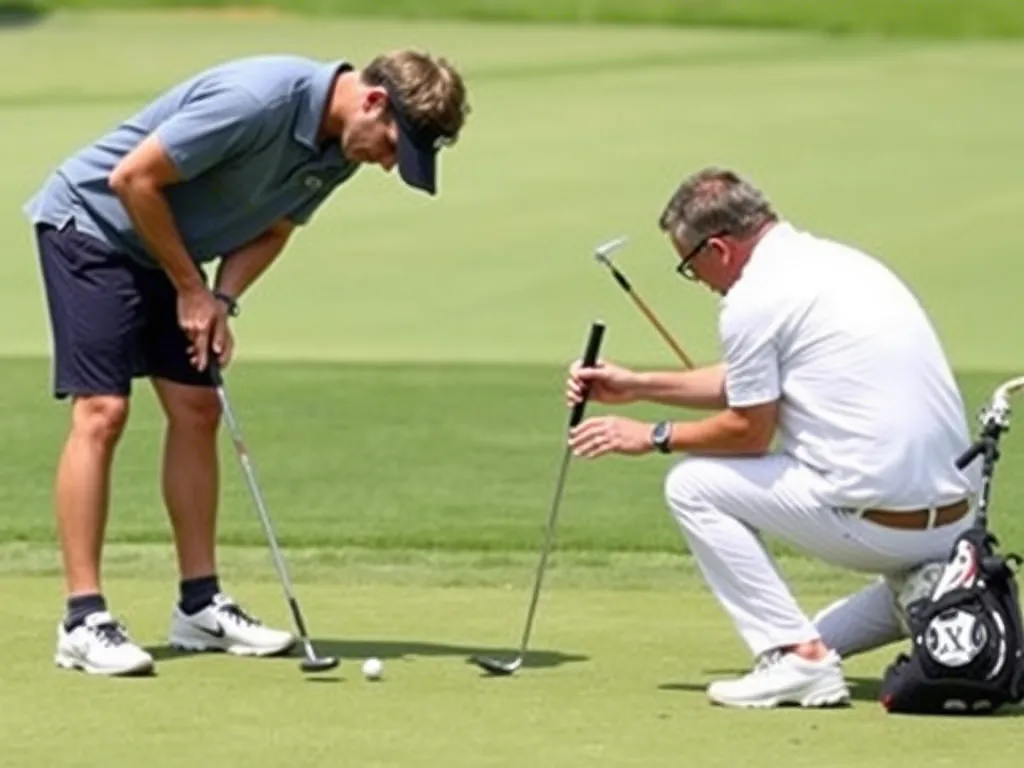How To Get Rid Of The Yips In Golf
The best way to get rid of the yips in golf is to relax your grip and focus on a smooth, steady stroke. When your hands get too tight or your mind starts to worry, short putts become harder to make. The yips often show up when your confidence drops or your putting stroke feels forced.
With the right drills, a relaxed grip, and a calmer mental game, you can rebuild your confidence and take control of your short putts again.
By keeping your grip pressure light, trusting your feel, and staying calm during the short game, you can take control and get your game back.
In this article, we’ll show you how to get rid of the yips in golf using simple tips that actually work.
You’ll learn what causes the yips, how to spot the signs, and how things like your grip, putting stroke, and mindset all play a role.

What Are the Yips in Golf and How They Affect Your Stroke
The yips are a sudden loss of control in your golf swing, usually during short putts or chip shots.
They often feel like involuntary hand or wrist spasms that show up when you’re nervous or under pressure. Many golfers describe it as a mental block that makes their putting stroke shaky, jerky, or stiff.
The yips don’t only affect beginners many experienced players and even pros struggle with them at some point. It’s a mix of mental stress and muscle tension, and it can mess with your confidence fast.
Who Gets the Yips in Golf and Why It Can Happen to Anyone
| Group of Golfers | Who Experiences Yips | Most Affected Shot Type |
| Amateur Golfers | 33% | Short putts |
| Senior Players (60+) | 48% | Putting and chipping |
| Professional Golfers | 28% | Putting under pressure |
| Beginners (1–2 years) | 15% | Chipping and pitch shots |
Note: This table shows that the yips can affect any golfer, but they’re most common in older players and during pressure shots like short putts.

Why Having the Yips in Golf Can Hurt Your Game
The yips aren’t just annoying they can change the way you play and feel about golf. What starts as one missed short putt can quickly lead to a loss of confidence.
Your putting stroke feels off, and every shot near the green becomes harder than it should be. The more you worry about it, the worse it gets. That’s why the yips are more than just a small problem they affect your whole mindset and performance.
Loss of Confidence from Missed Short Putts and Chipping Mistakes
The biggest problem with the yips is how they break your trust in your own game. Golf is built on confidence, especially in the short game.
When you start missing easy shots like short putts or chips, your focus shifts from playing the game to avoiding failure. This mental shift leads to hesitation, second-guessing, and more missed shots.
How Mental Pressure and Performance Anxiety Make the Yips Worse
Many golfers feel pressure during key shots, but the yips take it further. Even experienced players can feel tension in their hands and arms, making it nearly impossible to make a smooth putting stroke.
This anxiety builds, causing a mental block that keeps you from swinging freely. Over time, your body reacts to pressure with tight, jerky movements instead of calm, controlled strokes.
The Negative Feedback Loop That Damages Your Short Game
Once the yips show up, they often create a cycle that’s hard to break. You miss a short putt, feel embarrassed or frustrated, and then try too hard on the next one.
That stress leads to more tension, more mistakes, and more frustration. This is called a negative feedback loop, and it’s one of the main reasons the yips don’t go away on their own.

How the Yips Can Spread Beyond Your Putting Stroke
At first, the yips may only show up during putting. But if they’re ignored, they can affect other parts of your game. Some golfers develop yips during chipping, pitching, or even bunker shots.
When your confidence is shaken, it can impact your grip, rhythm, and decision-making in all areas of the short game.
What Causes the Yips in Golf Play and How Bad Habits Make It Worse
The yips don’t just happen by accident. They usually come from a mix of mental stress, muscle memory problems, and sometimes even physical conditions.
To fix the yips, it’s important to first understand where they come from and what makes them worse.
Mental Pressure and Fear of Missing Short Putts Under Stress
One of the most common causes of the yips is mental pressure. When golfers feel nervous or try too hard not to miss a shot, their muscles tighten and their putting stroke becomes jerky.
Fear of failure builds up and creates a mental block, especially when facing short putts.
How Performance Anxiety Affects Muscle Control and Focus
Performance anxiety is when the fear of messing up takes over your ability to focus. This happens a lot during competitive rounds or even casual games when friends are watching.
Your hands feel shaky, your grip gets tight, and your smooth tempo disappears. Over time, your muscle memory breaks down, and the stroke no longer feels natural.
Repetitive Bad Habits That Lead to Inconsistent Short Game
When a golfer uses the wrong technique over and over like gripping too hard or rushing the stroke those habits become locked in.
These repetitive bad habits build poor mechanics into your swing, especially in the short game, where precision matters. If not corrected, they can lead to inconsistent putting and chipped shots.
Rare Physical Causes Like Focal Dystonia in Golfers
In rare cases, the yips come from a condition called focal dystonia. This is a nerve and muscle disorder that causes involuntary movements during specific tasks like putting. While this is less common, it can be mistaken for mental pressure and often needs professional help to treat.
Main Causes of the Yips in Golf
| Cause | Description | Common Among | Fixable With Practice? |
| Mental Pressure | Fear of missing short shots creates tension and blocks focus | All players | Yes |
| Performance Anxiety | Nervousness and overthinking under pressure impact swing control | Competitive golfers | Yes |
| Repetitive Bad Habits | Poor grip, rushed stroke, or tense motion learned over time | Amateur and casual | Yes |
| Focal Dystonia (Physical) | Involuntary muscle movements caused by nerve issues | Rare (mainly older) | Needs medical attention |
Note: Most yips come from mental or behavioral causes, not physical ones. The good news is that with the right techniques, drills, and mindset training, most golfers can overcome the yips without needing medical help.
Symptoms to Look For the Yips in Golf
If you’re struggling with your short game and feel like your hands aren’t doing what you want, the yips may be the reason.
The signs often appear during short putts or chip shots, especially when you’re under pressure. Spotting the early symptoms of the yips in golf is the first step toward getting control back.
Freezing Over Short Putts Due to Golf Yips Under Pressure
One of the most common symptoms of the yips is freezing at address. You line up a short putt, but your hands won’t move. This hesitation is often caused by mental pressure, fear of missing, or overthinking. The longer you stand over the ball, the worse the tension builds, making your stroke feel stuck.
Shaky Hands and Tense Wrists During Chipping with the Yips
Golfers with the yips often feel shaky hands or tight wrist movement while chipping. These physical signs come from muscle tension and nervous energy.
Instead of a smooth motion, your stroke becomes jerky or stiff, which causes you to mis-hit the ball or chunk the shot.
Overthinking the Putting Stroke Mechanics with Golf Yips
If you keep second-guessing your putting stroke mechanics, adjusting your grip, or obsessing over your stance, it may be a symptom of the yips.
Overthinking stops you from swinging naturally and kills your feel. Your brain becomes too focused on control and not enough on rhythm.
Sudden Jerky Movements in Putting Caused by Yips
Another key symptom of golf yips is a sudden jerk or twitch during the stroke. This happens right before or during contact with the ball.
These movements are usually involuntary and come from muscle tension or fear of making a mistake. It often feels like your hands act on their own.
Losing Feel in the Short Game Because of Golf Yips
The yips can cause you to lose touch and feel around the greens, especially during short game shots. What once felt natural now feels forced or uncomfortable.
This is a sign your muscle memory is being blocked by stress or fear. It leads to a lack of distance control and shaky execution.
Avoiding Short Putts and Chip Shots Because of the Yips in Golf
Some golfers with the yips try to avoid pressure shots altogether. You may leave long putts short to avoid a tricky comeback or avoid chipping by putting from off the green.
This kind of performance avoidance shows a loss of confidence and growing fear around your short game.

How to Fix the Yips in Golf with Simple Putting Stroke Drills
Fixing the yips in golf starts with calming your mind, improving your grip, and retraining your body to trust the stroke. The key is to reduce tension, rebuild muscle memory, and restore confidence in your short game.
Below are proven techniques and simple drills that help golfers overcome the yips and regain control on the greens.
Change Your Putting Grip Style to Reduce Yips
Changing your grip is one of the most effective ways to break the pattern of the yips. By switching to a different putting grip, you disrupt the brain’s usual signal and create a fresh feel in your hands.
Popular grip styles to try:
- Claw grip – Lightens hand pressure and helps stabilize the stroke
- Pencil grip – Reduces wrist action and forces shoulder-driven motion
- Cross-handed grip (left-hand low) – Balances hands and promotes consistency
These grips are often used by pros to calm the hands and create smoother, more confident strokes.
Use Mental Training Techniques to Overcome Golf Yips
The yips often start in the mind. That’s why training your brain is just as important as fixing your swing. These mental drills help reduce anxiety and improve focus.
Techniques that work:
- Visualization – Picture the perfect stroke in your mind before swinging
- Breathing control – Take a slow breath before setup to relax your body
- Mindfulness – Stay present in the moment, instead of thinking about the outcome
Practicing these daily even off the course can help your body respond with more trust and less fear.

Try Physical Drills to Fix the Yips in Your Putting Stroke
You can also train your muscles to feel more natural and responsive through physical putting drills. These drills remove tension, improve hand control, and rebuild your short game confidence.
Top drills to practice:
- Eyes-closed putting – Focuses on feel and rhythm rather than sight
- One-handed putting – Trains the dominant hand to move independently and smoothly
- Gate drill with alignment sticks – Helps keep your stroke straight and centered
Regular practice of these drills helps build new, more stable habits.
Summary Table: Drills and Techniques to Fix Golf Yips
| Method | What It Fixes | Best For |
| Claw Grip | Reduces wrist tension and shaky hands | All levels |
| Cross-Handed Grip | Improves balance and control | Intermediate+ |
| Visualization & Breathing | Eases anxiety, builds mental focus | All golfers |
| Eyes-Closed Putting Drill | Improves feel and muscle memory | Beginner–Advanced |
| One-Handed Putting Drill | Trains smoother stroke and grip control | All levels |
| Gate Drill with Alignment Aid | Improves stroke path and consistency | Intermediate+ |
Note:
This table highlights the most effective grip changes, mental techniques, and practice drills for golfers dealing with the yips. While some methods like the claw grip or one-handed putting work well for beginners.
Best Tools That Help Beat the Yips in Golf for Short Putts
The right training tools can make a big difference when trying to beat the yips. From putter grips that reduce wrist tension to mats that help you practice your short game at home, these products are designed to help you stay calm, focused, and consistent.
Here are some of the best tools that golfers use to fight the yips and improve their putting control.
SuperStroke Traxion Tour Grip
Best for: Golfers with putting anxiety or shaky hands
How it helps:
This oversized grip reduces wrist movement and helps promote a smoother, more stable putting stroke. It also improves feel and reduces grip pressure key factors in beating the yips.
Perfect Practice Putting Mat
Best for: Golfers who want to rebuild confidence in their short game at home
How it helps:
This indoor putting mat helps players build consistency with short putts through daily repetition. It trains alignment, stroke path, and pace control great for those recovering from putting yips.
Odyssey White Hot OG Putter (Face-Balanced)
Best for: Players who need more control and balance in their putting stroke
How it helps:
This face-balanced putter reduces twisting during the stroke, which helps prevent the jerky movements common with the yips. It also has a soft face insert that improves feel.
EyeLine Golf Putting Alignment Mirror
Best for: Golfers who struggle with setup, aim, or stroke path
How it helps:
This tool provides instant feedback on eye position and stroke alignment. It helps eliminate bad habits and reinforces a square setup ideal for fixing mechanics affected by the yips.
PuttOut Pressure Putt Trainer
Best for: Golfers who want to train under pressure and improve focus
How it helps:
Designed to return only perfect putts, this tool helps develop confidence and precision under pressure. Great for resetting your mental game and creating a repeatable stroke.
Buying Guide – What to Look for in Anti-Yip Equipment to Improve Putting Confidence
If you’re struggling with putting yips, the right equipment can make a big difference in helping you regain control, feel, and confidence.
This buying guide will help you understand what features to look for when shopping for anti-yip golf equipment so you can make smarter decisions and get results faster.
Choosing the Best Putter Grip for Yips and Wrist Control
One of the first things to consider is the grip on your putter. An oversized or ergonomic grip can reduce wrist action and make your hands feel more stable.
Look for grips that:
- Are oversized or pistol-shaped to reduce tension
- Help promote a light grip pressure
- Feel comfortable in your hands during long rounds
Grips like the SuperStroke Tour are often used by pros who deal with putting tension.
Why Face-Balanced Putters Are Better for Golfers with Yips
If your stroke feels shaky or inconsistent, a face-balanced putter may help. These putters are designed to stay square throughout the stroke, making them ideal for golfers who struggle with hand-twisting or stroke instability caused by the yips.
Benefits include:
- More control over direction
- Helps promote a pendulum-style putting motion
- Reduces the chances of pulling or pushing short putts

Using Stroke Trainers to Improve Muscle Memory and Feel
Putting stroke trainers are a great option for building consistency and rewiring your muscle memory. These tools guide your hands along the right path, helping you develop a repeatable motion.
Popular types of stroke trainers:
- Alignment mirrors for eye and shoulder positioning
- Path guides to keep your stroke straight
- Pressure trainers that return only perfect putts
These tools help take the focus off mechanics and bring back feel.
Budget-Friendly Golf Tools That Help Fix the Yips
You don’t need to spend a lot to fix the yips. Many great anti-yip training tools and putting aids are available at affordable prices.
Tips for budget-conscious golfers:
- Choose 1–2 essential tools like a grip and putting mat
- Avoid overbuying; start with simple drills and one feedback tool
- Look for multi-use items, like foldable mats or 2-in-1 stroke trainers
Value-focused tools like the PuttOut Trainer or basic alignment sticks can go a long way with regular use.
Additional Factors to Consider When Buying Anti-Yip Golf Equipment
Other things to think about:
- Feel and feedback: Choose tools that give instant response to your stroke
- Ease of use: Stick with gear that’s simple and doesn’t add stress
- Storage and portability: If you practice at home, look for tools that are compact and easy to store
Buying the right equipment should help you feel more in control, not more confused.
FAQs
Can you permanently get rid of the yips in golf?
Yes, many golfers have successfully overcome the yips through consistent practice, mental training, and sometimes changes in technique or equipment. While the yips can be challenging, they’re not permanent.
By addressing both the mental and physical aspects of your game, you can regain confidence and control on the greens.
Are the yips more of a mental or physical issue?
The yips are primarily a mental issue, often triggered by performance anxiety or overthinking. However, they can also have physical manifestations, such as involuntary muscle movements or tension.
In some cases, a neurological condition called focal dystonia may be involved. Addressing both the psychological and physical components is key to overcoming the yips.
What type of putter is best for golfers dealing with the yips?
Golfers struggling with the yips often benefit from face-balanced putters, which promote a more stable stroke.
Additionally, putters with heavier heads or thicker grips can help reduce wrist action and provide better control. It’s essential to try different options to see what feels most comfortable and effective for your stroke.
Are there specific drills to help overcome the yips?
Yes, several drills can help retrain your muscle memory and reduce anxiety:
Eyes-closed putting: Enhances feel and reduces overreliance on visual cues.
One-handed putting: Builds confidence and promotes a smoother stroke.
Gate drill with alignment sticks: Improves stroke path and consistency.
Regularly practicing these drills can help you regain control and confidence in your putting.
Can changing my grip help with the yips?
Absolutely. Altering your grip can disrupt negative patterns associated with the yips. Grips like the claw, cross-handed, or pencil grip can reduce wrist tension and promote a more stable stroke.
Experimenting with different grips can help you find one that feels comfortable and effective.
How important is mental training in overcoming the yips?
Mental training is crucial. Techniques such as visualization, deep breathing, and mindfulness can help reduce anxiety and improve focus.
Establishing a consistent pre-shot routine and using positive self-talk can also reinforce confidence and reduce the likelihood of the yips occurring.
Should I seek professional help to deal with the yips?
If the yips persist despite self-help strategies, consulting a golf instructor or sports psychologist can be beneficial.
They can provide personalized guidance, identify underlying issues, and offer targeted interventions to help you overcome the yips effectively.
Conclusion – You Can Beat the Yips in Golf
The yips can be frustrating, but they don’t have to control your game forever. Many golfers, beginners and pros alike, have struggled with shaky hands, missed short putts, and mental blocks. But the truth is, you can get rid of the yips in golf with the right mindset, smart practice, and a few helpful tools.
Start by making small changes: try a new putting grip, focus on calming your mind, and use drills that improve feel and consistency. Practice regularly, but don’t overthink every shot. Let your body learn a smooth, natural motion again.
Remember, confidence grows with repetition and patience. If you’re working on your short game at home with a putting mat or staying focused under pressure on the course, every step forward helps.
Believe in your swing. Trust your hands. Stay calm. The yips are beatable and your best golf is still ahead.
I Gained 70 YDS With DRIVER In Only 20 GOLF SHOTS
Posts References:
Yips – Diagnosis and treatment – Mayo Clinic
How To Stop the Yips in Golf Once and For All – Pyramid Golf